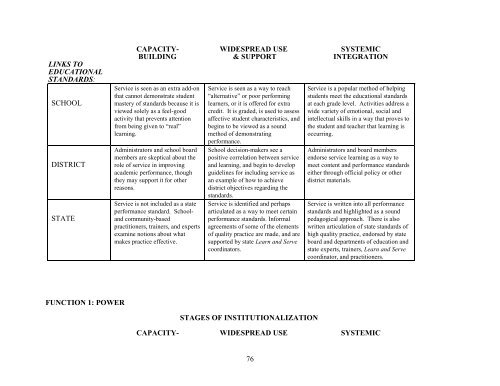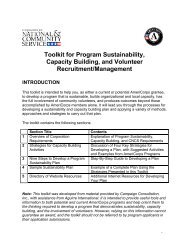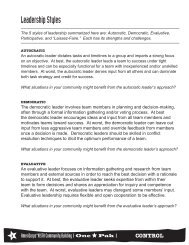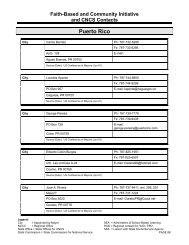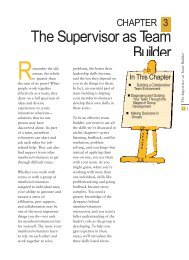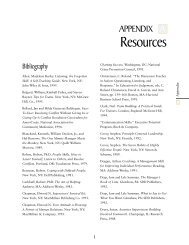MAKE IT LAST FOREVER: THE ... - National Service Resource Center
MAKE IT LAST FOREVER: THE ... - National Service Resource Center
MAKE IT LAST FOREVER: THE ... - National Service Resource Center
Create successful ePaper yourself
Turn your PDF publications into a flip-book with our unique Google optimized e-Paper software.
LINKS TO<br />
EDUCATIONAL<br />
STANDARDS:<br />
SCHOOL<br />
DISTRICT<br />
STATE<br />
FUNCTION 1: POWER<br />
CAPAC<strong>IT</strong>Y- WIDESPREAD USE SYSTEMIC<br />
BUILDING & SUPPORT INTEGRATION<br />
<strong>Service</strong> is seen as an extra add-on<br />
that cannot demonstrate student<br />
mastery of standards because it is<br />
viewed solely as a feel-good<br />
activity that prevents attention<br />
from being given to “real”<br />
learning.<br />
Administrators and school board<br />
members are skeptical about the<br />
role of service in improving<br />
academic performance, though<br />
they may support it for other<br />
reasons.<br />
<strong>Service</strong> is not included as a state<br />
performance standard. Schooland<br />
community-based<br />
practitioners, trainers, and experts<br />
examine notions about what<br />
makes practice effective.<br />
<strong>Service</strong> is seen as a way to reach<br />
“alternative” or poor performing<br />
learners, or it is offered for extra<br />
credit. It is graded, is used to assess<br />
affective student characteristics, and<br />
begins to be viewed as a sound<br />
method of demonstrating<br />
performance.<br />
School decision-makers see a<br />
positive correlation between service<br />
and learning, and begin to develop<br />
guidelines for including service as<br />
an example of how to achieve<br />
district objectives regarding the<br />
standards.<br />
<strong>Service</strong> is identified and perhaps<br />
articulated as a way to meet certain<br />
performance standards. Informal<br />
agreements of some of the elements<br />
of quality practice are made, and are<br />
supported by state Learn and Serve<br />
coordinators.<br />
STAGES OF INST<strong>IT</strong>UTIONALIZATION<br />
<strong>Service</strong> is a popular method of helping<br />
students meet the educational standards<br />
at each grade level. Activities address a<br />
wide variety of emotional, social and<br />
intellectual skills in a way that proves to<br />
the student and teacher that learning is<br />
occurring.<br />
Administrators and board members<br />
endorse service learning as a way to<br />
meet content and performance standards<br />
either through official policy or other<br />
district materials.<br />
<strong>Service</strong> is written into all performance<br />
standards and highlighted as a sound<br />
pedagogical approach. There is also<br />
written articulation of state standards of<br />
high quality practice, endorsed by state<br />
board and departments of education and<br />
state experts, trainers, Learn and Serve<br />
coordinator, and practitioners.<br />
CAPAC<strong>IT</strong>Y- WIDESPREAD USE SYSTEMIC<br />
76


